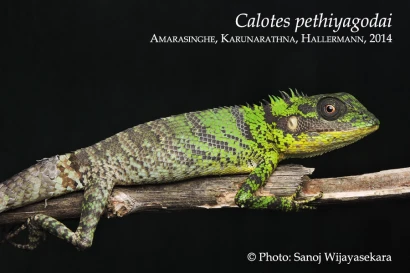
Discoveries
3. Calotes pethiyagodai
Amarasinghe, Karunarathna & Hallermann, 2014
Publication :
Amarasinghe AAT, DMSS Karunarathna, J Hallermann, J Fujinuma, H. Grillitsch & PD Campbell (2014). A new species of the genus Calotes (Squamata: Agamidae) from high elevations of the Knuckles Massif of Sri Lanka. Zootaxa 3785 (1): 59–78.
Remarks :
We discovered Calotes pethiyagodai from the northern face of the Knuckles massif (>900 m above sea level) of Sri Lanka. This species is distributed in
Riverstone (1200 m a.s.l.), Dotalugala (~1500 m a.s.l.), Gammaduwa (~900 m a.s.l.), Kobonilagala (1400 m a.s.l.), Rangala (1400 m a.s.l.), Cobet’s Gap (1000 m a.s.l.) and Thangappuwa (1000 m a.s.l.) of the Knuckles massif. This species most closely resembles Calotes liocephalus Günther, 1872 which has an isolated population in the central highlands and is only known from Pundaluoya (1000m a.s.l.), Dickoya (1200m a.s.l.), Upcot (1400m a.s.l.), Agrapatanas (1665m a.s.l.) and Peak Wilderness (Sri Pada >1400m a.s.l.). The populations from Pundaluoya and Dickoya appear to be locally extinct from the wild and are known only from museum specimens collected over 120 years ago.
Chena cultivations, illegal timber felling, encroachments, manmade fire, soil erosion, garbage dumping, habitat destruction, unplanned constructions, rock exploitations, illegal gem mining, and land fillings are all identified as main reasons for habitat loss and fragmentation in the Knuckles region. These threats to Calotes pethiyagodai could be exacerbated by the
surrounding cardamom cultivations that indiscriminately use pesticides. Road kills are an additional threat to C. pethiyagodai (personal observations in the Riverstone area). Specimens of C. pethiyagodai have been recorded by Amarasinghe et al. (2009) that were dead for reasons unknown.
Etymology:
The species epithet is an eponym latinized in the genitive singular, honouring Tilak Rohan David Pethiyagoda (Pethiyagoda, R.), a Rolex awarded conservationist and the founder of the Wildlife Heritage Trust of Sri Lanka (WHT), for his dedication and contribution to biodiversity conservation in Sri Lanka; his leading contribution to herpetological and ichthyological explorations in the Indian Subcontinent; and the great work he has done in order to restore and preserve the forests in the central highlands is highly commendable. His contributions are extremely important and they undoubtedly inform the many new taxonomists emerging out of India and Sri Lanka, especially at a time such as now when new taxonomists are very much in demand.
English name: Pethiyagoda’s Crestless Lizard
Sinhala (local) name: පෙතියගොඩගේ නොසිලු-කටුස්සා
Tamil (local) name: Pethiyagodavin Oonan.
Further readings:
Amarasinghe, AAT, DMSS Karunarathna & DE Gabadage (2009). Current status of Calotes liocephalus Günther, 1872 (Reptilia: Agamidae) of Sri Lanka. Journal of Threatened Taxa 1, 553–557.
Riverstone (1200 m a.s.l.), Dotalugala (~1500 m a.s.l.), Gammaduwa (~900 m a.s.l.), Kobonilagala (1400 m a.s.l.), Rangala (1400 m a.s.l.), Cobet’s Gap (1000 m a.s.l.) and Thangappuwa (1000 m a.s.l.) of the Knuckles massif. This species most closely resembles Calotes liocephalus Günther, 1872 which has an isolated population in the central highlands and is only known from Pundaluoya (1000m a.s.l.), Dickoya (1200m a.s.l.), Upcot (1400m a.s.l.), Agrapatanas (1665m a.s.l.) and Peak Wilderness (Sri Pada >1400m a.s.l.). The populations from Pundaluoya and Dickoya appear to be locally extinct from the wild and are known only from museum specimens collected over 120 years ago.
Chena cultivations, illegal timber felling, encroachments, manmade fire, soil erosion, garbage dumping, habitat destruction, unplanned constructions, rock exploitations, illegal gem mining, and land fillings are all identified as main reasons for habitat loss and fragmentation in the Knuckles region. These threats to Calotes pethiyagodai could be exacerbated by the
surrounding cardamom cultivations that indiscriminately use pesticides. Road kills are an additional threat to C. pethiyagodai (personal observations in the Riverstone area). Specimens of C. pethiyagodai have been recorded by Amarasinghe et al. (2009) that were dead for reasons unknown.
Etymology:
The species epithet is an eponym latinized in the genitive singular, honouring Tilak Rohan David Pethiyagoda (Pethiyagoda, R.), a Rolex awarded conservationist and the founder of the Wildlife Heritage Trust of Sri Lanka (WHT), for his dedication and contribution to biodiversity conservation in Sri Lanka; his leading contribution to herpetological and ichthyological explorations in the Indian Subcontinent; and the great work he has done in order to restore and preserve the forests in the central highlands is highly commendable. His contributions are extremely important and they undoubtedly inform the many new taxonomists emerging out of India and Sri Lanka, especially at a time such as now when new taxonomists are very much in demand.
English name: Pethiyagoda’s Crestless Lizard
Sinhala (local) name: පෙතියගොඩගේ නොසිලු-කටුස්සා
Tamil (local) name: Pethiyagodavin Oonan.
Further readings:
Amarasinghe, AAT, DMSS Karunarathna & DE Gabadage (2009). Current status of Calotes liocephalus Günther, 1872 (Reptilia: Agamidae) of Sri Lanka. Journal of Threatened Taxa 1, 553–557.






